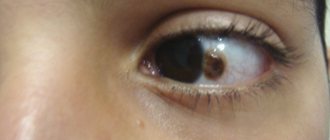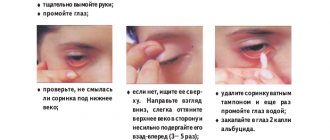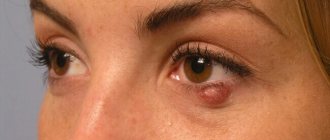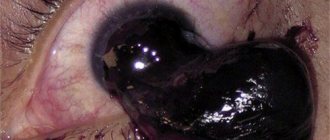Hemorrhage is a pathological process in which blood leaves the blood vessel. Bleeding from the eyes can occur for a variety of reasons, which must be established in order to prescribe rational treatment to the patient.
Related articles:
How many liters of blood are in the body of an adult and a child? Is brushing your teeth allowed before donating blood? Types of blood groups in humans - which is the rarest When does blood renewal occur in men and women - after how many years What does a blood test for RW mean?
How to relieve swelling?
After injury, in addition to a bruise, swelling may appear at the site of the impact. Often this complication occurs with a hematoma of the eyelid. To reduce tumors, you can use recipes from traditional medicine:
- per day you need to make 3-4 lotions from grated raw potatoes. This product perfectly relieves inflammation and accelerates skin regeneration;
- apply cabbage leaves several times a day;
- make compresses from crushed plantain leaves.
These products will speed up the healing process and remove swelling in the facial area. You should not drink alcohol for several days. This may make the swelling worse.
Causes of hemorrhage
Bleeding in the eye occurs due to damage to the small blood vessels in the organs of vision. Violation of the integrity of the vascular wall can occur under the influence of a number of factors. Most often, this pathology is traumatic in nature, developing as a result of injury to the organs of vision, head and even chest or torso. Ophthalmic hemorrhage can occur even with minor damage (contusion).
In addition to traumatic injuries, the following factors can provoke hemorrhage inside the ocular structure:
- oncological processes;
- blood clotting disorder;
- viral inflammation of the eye mucosa;
- taking medications that thin the blood;
- lack of vitamin K in the body;
- diabetic retinopathy;
- atherosclerosis;
- microaneurysms;
- hypertension;
- endarteritis;
- retinal defects;
- anemia and other blood diseases;
- myopia;
- connective tissue pathologies.
The cause of intraocular hemorrhage can be excessive physical activity, which includes not only increased strength loads, but also pushing during childbirth, severe coughing and profuse vomiting in some diseases. A loud cry can also cause blood to accumulate in the eye cavity.
Sometimes pathology is a complication after surgery.
Features of treatment
Eye drops for hemorrhage are used in mild forms of pathology, when damage to blood vessels is minor. Therapy is selected only after a detailed examination, identifying the cause and characteristics of the development of the pathological phenomenon. In the selection of medications, the location of ophthalmic hemorrhage plays an important role. The following forms of intraocular hemorrhage are distinguished:
- Hyphema. Accumulation of blood is observed throughout the cavity of the anterior chamber of the eye. Most often it occurs as a result of contusion and is manifested by severe pain and blurred vision. The blood formation in the eye has a uniform red consistency with smooth contours. There are 4 stages of hyphema development. Small blood clots quickly resolve with eye drops, but large hyphemas that cover almost the entire pupil require surgical intervention.
- Hemophthalmos. Hemorrhage occurs inside the vitreous body and is characterized by the formation of a homogeneous brown formation directly behind the lens. Taking into account the degree of damage, partial (deterioration of vision due to complications) and complete (complete loss of vision) hemophthalmos are distinguished. The disease is manifested by the following symptoms: flashes of light, scotomas, blurred vision, decreased visual acuity. This form of hemorrhage is the most dangerous and, if left untreated, can cause retinal detachment or atrophy of the eyeball, which ultimately leads to complete loss of vision. Drops are prescribed for bleeding in the eyes; in severe cases, surgical intervention is performed.
- Extravasation into the retina. In case of damage to the retinal vessels, a bloody spot forms in the white of the eye. The pathology is manifested by the following symptoms: blurred image, flickering “spots” before the eyes, the formation of a grid, deterioration in the quality of vision. Extensive hemorrhages lead to vision loss and can cause the development of retinopathy. Moderate lesions are treated with eye drops, extensive hemorrhages are eliminated surgically.
- Extravasation into the orbital cavity. The pathology occurs as a result of contusion of the orbit of the eye, against the background of blood pathologies or as a result of vasculitis. Hemorrhages are additionally observed in the conjunctiva and skin of the eyelids. Ocular hemorrhages are accompanied by the following symptoms: diplopia, limited pupil mobility, blurred vision, severe bulging eyes. Treatment of this form is carried out through systemic exposure and the use of eye drops.
In any form of the disease, the white of the eye turns red. The degree of redness depends on the severity of the hemorrhage. When the first signs of ophthalmic hemorrhage appear, you should consult an ophthalmologist. Quick diagnosis to detect the cause and select effective treatment. In addition to bed rest, cold compresses and bandages with an antiseptic, drug therapy is prescribed, which includes a number of drugs aimed at strengthening blood vessels and stopping the blood.
For minor injuries, eye drops are prescribed; in more serious cases, surgery is performed.
When to see a doctor
Eye bleeding does not always require medical attention
Eye bleeding is a fairly common problem, and in many cases it does not require medical attention.
However, if blood is released from the eye due to a certain disease or this symptom begins to cause problems, then in such a situation it is better to immediately consult a doctor.
For some types of eye bleeding, such as vitreous hemorrhage or hyphema, it is important to get medical help as soon as possible.
Causes of decreased vision
Reasons for overloading the body:
- eye strain from glare and flickering of the monitor. The eyes get tired from overload on the lens muscles. There may be a risk of cataracts;
- Eye strain from frequently changing images can cause headaches;
- huge amounts of information lead to overwork of the visual centers of the brain;
- uneven loads on the back muscles and spine can cause the development of osteochondrosis and neuralgia;
- prolonged loads on the hands - this can subsequently result in carpal tunnel syndrome;
- low mobility will lead to decreased immunity and stress on the veins;
- emotional mental disorders occur when spending too much time in front of the computer.
It is possible to minimize damage to health, especially if a decrease in visual acuity is noticed, if you follow the recommendations of specialists.
Causes
There are many reasons for a bruise in the eye from an impact:
- Internal bleeding that spreads to the anterior chamber of the eye, causing a red spot visible on the surface of the cornea. The condition does not affect visual acuity. The liquid quickly resolves, so most often no therapeutic measures are used.
- Hemorrhage extending to the vitreous body. Occurs as a result of damage to the walls of blood vessels. Characteristic is a small spot. Decreased visual acuity often occurs. After the impact, spots, dots, and stripes appear before the eyes. For medical treatment, an emergency call to an ambulance is required. In the absence of therapy, retinal detachment and complete disruption of the nutrition of the eyeball will occur.
- Retinal hemorrhage. Symptoms of the condition depend on the degree of damage to the vessel. After the blow, dots appear in front of the eyes, objects appear in double. If the impacts accompanied by damage to the retina are constant, this leads to a decrease in visual acuity, up to its complete loss.
- Hemorrhage into the cornea is accompanied by painful sensations. Blood is located on the surface of the eyes.
- Minor hemorrhages that appear after surgery. If they are small, the fluid will resolve on its own and no treatment is required.
- Increased blood or intraocular pressure. If left untreated, the vascular wall ruptures, causing increased pressure on the retinal area.
- Diabetes. If left untreated, deformation of the capillaries that supply the eyes occurs. The nutrition of tissues is disrupted, which causes their death and decreased function.
- Malignant and benign neoplasms. Capillaries break as the tumor grows.
- Increased physical activity. Lead to rupture of the vessel wall due to high voltage and pressure.
Types of eye bleeding and their symptoms
The symptoms that occur with eye bleeding depend on its cause.
In medical practice, bleeding inside the eye is called hemorrhage into the eye. There are the following types of such hemorrhages.
Subconjunctival hemorrhage
Subconjunctival hemorrhage is a common type of eye bleeding. It occurs against the background of destruction of blood vessels.
In such cases, blood may appear in the whites of the eyes. This effect may be frightening, but in fact it is not accompanied by pain or any other discomfort. Moreover, in such situations, human health is usually not in danger.
Subconjunctival hemorrhage can be traumatic and spontaneous. Traumatic - usually results from minor injuries, such as rough rubbing of the eye. Spontaneous - Occurs due to the development of medical conditions such as high blood pressure (hypertension) or diabetes. These problems can cause blood vessels to become significantly weakened and more susceptible to destruction.
The authors of an article published by the scientific journal StatPearls in 2020 noted that subconjunctival hemorrhage usually does not require medical intervention and resolves in one to two weeks. However, if such a problem becomes the result of underlying medical conditions, then treatment of these conditions is required to eliminate it.
Hyphema
Hyphema is a less common but more serious pathological abnormality. In hyphema, blood collects in the front of the eye, between the cornea and iris.
Typically, hyphema results from traumatic injury to the eye.
Symptoms of hyphema include the following:
- pain;
- bleeding in the front of the eye;
- increased sensitivity to light;
- visual disturbances;
- nausea or vomiting if eye pressure rises sharply.
Deep bleeding
Bleeding that occurs deep in the eye and has no external manifestations includes the following:
- Hemorrhage into the vitreous body. The transparent part of the eye is called the vitreous body. A vitreous hemorrhage can cause blood to leak into the area.
- Subretinal hemorrhage. Bleeding occurs under the retina of the eye.
- Submacular hemorrhage. Bleeding occurs between the retinal pigment epithelium and the retina itself.
With the problems listed above, the following may occur:
- the appearance of floats in the field of view;
- blurred vision;
- the appearance of a red tint in the field of vision;
- Scotoma is a visual disorder in which blind spots are observed in the field of vision.
Hemolacria
The term “hemolacria” in medical practice usually refers to the secretion of bloody tears. Their source may be the lacrimal glands, but sometimes the problem develops due to physiological disorders in other parts of the eye.
Injuries to the inner eyelid may cause bleeding from the affected area. If the cause of the bleeding is deeper, then bloody tears may be released from the lower border of the eye.
Hemorrhage into the anterior chamber of the eye (hyphema)
The anterior chamber of the eye is the area between the cornea (the clear, convex “lens” of the eye) and the iris (the disk with the pupil in the center that gives our eyes their unique color) and the lens (the clear lens behind the pupil). Normally, this area is filled with an absolutely transparent liquid - the moisture of the anterior chamber; the appearance of blood is called hyphema or hemorrhage into the anterior chamber of the eye.
The causes of hyphema, although they seem completely unrelated, carry at their core the same element - rupture of the vessel. They are conventionally divided into three groups:
- Trauma is the most common cause of hyphema.
- trauma can be penetrating - damage to the eye is accompanied by communication between the internal contents of the eyeball and the environment; such trauma often occurs from the action of sharp objects, less often from the action of blunt objects;
- the injury is not penetrating - while the external integrity of the eye, its internal structures are destroyed, which leads to the outflow of blood into the anterior chamber of the eye; such injury is almost always a consequence of the action of blunt objects;
- The group of injuries also includes all types of operations on the organs of vision, which may be accompanied by hyphema.
- Diseases of the eyeball associated with the formation of new, defective vessels inside the eye (neovascularization). Newly formed vessels have structural defects that cause their increased fragility, which is associated with the outpouring of blood into the anterior chamber of the eye with little or no impact. Such diseases include:
- diabetic angiopathy (a consequence of diabetes mellitus);
- retinal vein blockage;
- retinal disinsertion;
- intraocular tumors;
- inflammatory diseases of the internal structures of the eye.
- Diseases of the body as a whole:
- chronic alcohol and drug intoxication;
- blood clotting disorder;
- oncological diseases;
- systemic connective tissue diseases.
degree of hyphema
Hyphema, based on the level of blood in the upright position of the patient, is divided into four grades:
- The 1st visually anterior chamber of the eye is occupied by blood by no more than a third;
- 2nd blood fills the anterior chamber of the eye to no more than half;
- The 3rd chamber is filled with blood by more than ½, but not completely;
- 4th total filling of the anterior chamber of the eye with blood “black eye”.
Despite the obvious conventionality of this division, it is of practical importance for the choice of treatment tactics and prognosis of the outcome of hemorrhage. The degree of hyphema is also determined by its symptoms and their severity:
- Visually detectable presence of blood in the anterior chamber of the eye;
- Decrease in visual acuity, especially in a lying position, to the point that only the sense of light is preserved and no more (at 3-4 degrees);
- Blurred vision in the affected eye;
- Fear of bright light (photophobia);
- Sometimes there is a feeling of pain.
The diagnosis of hemorrhage in the anterior chamber of the eye at a doctor’s appointment usually does not cause any significant difficulties and is based on technically simple manipulations:
- Visual inspection;
- Tonometry – measurement of intraocular pressure;
- Visometry – establishing visual acuity;
- Biomicroscopy is an instrumental method using a special ophthalmological microscope.
manifestations of hemorrhage in the anterior chamber of the eye
Surgical treatment is performed in case of complicated hyphema; indications for surgery are:
- There is no effect from the use of drugs (the blood does not resolve) within 10 days;
- The blood has lost its fluidity - a clot has formed;
- The cornea began to stain with blood;
- Intraocular pressure does not decrease during treatment.
If the operation is refused, such serious complications as glaucoma, uveitis, as well as a significant drop in visual acuity may develop due to a decrease in the transparency of the blood-stained cornea.
Prevention
Despite the danger in most cases of hemorrhage in the eye of a newborn, it is necessary for the expectant mother to comply with preventive measures. This will allow you to avoid excessive anxiety after childbirth, when strength, including mental strength, needs to be restored. Preventive measures include:
- Proper breathing during the entire birth process. Before giving birth, you should attend a school for expectant mothers, where specialists teach proper breathing and behavior during the birth of a baby. You can't scream during childbirth. This hinders not only the woman herself, but also the baby, because for him being born is hard work.
- Lifting weights is trusted to others. This is necessary so that the gestational age corresponds to the norm, and the baby is not born earlier than expected.
- The right choice of a maternity hospital with high-quality conditions for obstetric care.
- Absence of unnecessary worries, strict adherence by the expectant mother to the doctor’s recommendations, especially in the presence of chronic diseases.
- Adequate nutrition during pregnancy, taking vitamin complexes that contribute to the proper development of the fetus.
- Caring for a woman’s condition throughout pregnancy, both from the expectant mother and from loved ones.
How to remove redness: treatment methods
Treatment is prescribed depending on the degree of injury to the eyeball; it will be individual for each patient. Therapy for hemorrhage in the optic organ is aimed at preserving:
- eyes and restoration of the basic functions of damaged tissues;
- vision or its complete restoration.
Different types of hemorrhages have their own treatment methods.
Hyphema: drops for redness
This is an accumulation of a blood clot in the anterior chamber of the eyeball. With hyphema, a person sees poorly, fog or a veil appears before his eyes, and visual acuity is greatly reduced.
Any treatment for hemorrhage is prescribed by a specialist based on an examination. Depending on the clinical picture, the following drugs may be prescribed:
- Eye drops that will relieve pain and inflammation: Prednisolone, Dexamethasone, etc.
- Hormonal containing glucocorticosteroids.
- Aminocaproic acid or other agents to stop bleeding.
- Special medications that strengthen blood vessels and help stagnant blood dissolve.
- Drugs that help normalize eye pressure.
Photo 1. Hyphema of the eye. There is extensive hemorrhage in the anterior chamber, as well as damage to the ocular vessels.
Vessels burst - this is hemophthalmos. How to treat red eye
Hemophthalmos is a disease in which blood, resulting from rupture of blood vessels, accumulates in and around the vitreous body.
If the hemorrhage is total or subtotal, then the patient must be urgently hospitalized, since in such situations, surgical intervention will most likely be required, after which complex therapy will be prescribed. With a mild form of hemophthalmos, the patient should remain in bed, wear an eye patch and eat properly. The same medications are used for any form of the disease:
- Vikasol or other hemostatic agent;
- drops to remove blood clots;
- vitamin complexes;
- hormonal drugs;
- calcium gluconate injections.
In addition to medications, electrophoresis is prescribed. During this procedure, the drug is injected directly into the eye area using electrical waves. Often, for hemophthalmia, aloe injections are prescribed for rapid cell regeneration and improvement of the patient's condition.
Photo 2. Hemophthalmos in the eye. The eye vessels are seriously damaged, the whites are completely swollen with blood.
Retinal hemorrhage
In most cases, blood enters the retina of the eye due to injury. There are several degrees of eyeball contusion:
- Mild - slight swelling of the cornea or retina without tissue damage.
- Moderate - swelling with damage to the tissue of the eyeball, and vision is greatly impaired.
- Severe - observed when the retina and blood vessels are ruptured, and the lens may be damaged. The consequence is complete loss of vision.
Hemorrhage does not always require special treatment. If blood stains do not damage the structure of the eyeball, they will simply resolve over time. If the symptoms are dangerous, the specialist may prescribe drug therapy or surgery.
Medicines prescribed for the treatment of hemorrhage:
- Injections of special vascular drugs to improve the condition of the walls of blood vessels.
- Corticosteroids. Used for severe swelling of the retina of the eyeball.
If drug treatment does not help, laser surgery is performed, during which the damaged vessels are removed and blood circulation is restored.
Photo 3. Fundus of the eye with retinal hemorrhage. Moderate swelling, in this case laser correction is required.
It is worth noting that laser therapy is the most effective method of treating retinal hemorrhage.
Medicines for damage to the orbital cavity
Currently, there are many medications that are used in the treatment of hemorrhage:
- herbal based;
- products with heparin;
- based on vitamin B;
- warming agents.
All medications are sold in pharmacies.
In case of hemorrhage, you can use badyagu; it has a decongestant, analgesic effect and improves blood circulation.
Treatment
Bruising most often goes away on its own, but to speed up the process, the doctor may prescribe drops for resorption. If your eyes bleed regularly, specific treatment is required. Injectable medications may be used.
There is no need to self-prescribe medications. It is necessary to obtain a doctor's answer regarding the diagnosis and his comments on treatment tactics, and the ophthalmologist can cancel the drug that he initially prescribed. If artificial tears are suitable for severe redness, then in case of inflammation antiseptic drops are indicated. The inflamed sclera will have to be treated with antibiotics and steroid drops.
Acute glaucoma requires surgical intervention. The operation is fraught with complications, but provides emergency assistance, which is extremely important in the development of irreversible processes. If possible, laser correction is performed.
If blood circulation is impaired, eye exercises are indicated, but to speed up the recovery process, vitamins with blueberries and vascular agents are additionally prescribed. Treatment after injury includes individual selection of glasses and medications.
Dear readers of the 1MedHelp website, if you still have questions on this topic, we will be happy to answer them. Leave your reviews, comments, share stories of how you dealt with similar bleeding! Your life experience may be useful to other readers.
Why is there bleeding from the eye and what to do in such a situation?
Blood from the eyes may visually appear as bleeding or hemorrhage. Bleeding is the leakage of blood through a violation of the integrity of the ocular structures. A type of symptom is hemolacria. Translated from Latin as “tears of blood.” Hemorrhage is an accumulation of blood in any area of the eye.
Causes
The most common reason why blood flows from the organ of vision is damage to the eye with a violation of the integrity of the vascular wall. Bleeding from the eyes can occur in both an adult and a child. There may be pure blood or in combination with tears (hemolacria).
Bleeding from the eyes is caused by reasons related to:
- mechanical damage caused by injury, burn;
- condition after surgery (traumatization of eye structures);
- extragenital endometriosis.
Extragenital endometriosis is a rare disease characterized by an atypical arrangement of tissue similar to the endometrium. One of the localization options is the conjunctiva of the optic organ. With endometriosis, blood flows from the eyes during menstruation.
The accumulation of blood clots in the eyes is caused by:
- excessive physical activity (heavy lifting, pushing during childbirth);
- exposure to extremely low or high temperatures;
- fragility of the vascular wall due to vitamin deficiency;
- vascular atherosclerosis;
- arterial hypertension;
- diabetes;
- blood diseases;
- oncological diseases of the lacrimal glands or ducts;
- severe course of ophthalmological diseases.
Somatic diseases cause disturbances in the structure of the vascular wall, which increases the tendency to rupture. Excessive exposure to the body (temperature, stress) leads to overstrain of blood vessels and their rupture.
Localization of hemorrhages
Areas of hemorrhage may be located in the following places:
- skin around the eyes;
- mucous membrane;
- iris;
- vitreous body;
- retina.
Superficial hemorrhages not associated with internal diseases do not require medical attention. This symptom goes away on its own in about 1 week.
Deeper hemorrhages, as well as a combination with blurred vision, pain, and other eye symptoms, require mandatory consultation with an ophthalmologist.
What to do if there is bleeding from the eye?
If blood appears from the eye organ, be sure to remove your glasses and contact lenses.
A person with any bleeding should be given first aid. It is to stop bleeding. If there is bleeding from the eyes as a result of an injury, then you need to apply ice or something cold to the damaged organ.
Main types of treatment:
- conservative;
- surgical;
- folk
Hemolacria caused by endometriosis is treated with hormonal drugs, as well as surgical removal of pathological tissue.
Hemorrhages usually resolve on their own. To speed up the process of resorption of a bruise on the skin, you can use local remedies: “Badyaga”, “Heparin ointment”, “Troxevasin”.
In some cases, surgery is required. The operation involves removing blood clots or removing elements of the eye organ. The necessity and extent of the operation is determined by the doctor based on examination and examination data.
ethnoscience
Folk remedies are moderately effective. It is recommended to combine them with medications. Then the effect will come much faster.
- Applying ice from purified water or chamomile infusion. Ice is applied for a few seconds, then a break is taken. Repeat several times.
- Lotions with fresh cabbage juice. Grind the cabbage leaf and squeeze out the juice. Soak a cotton pad and apply to your eyelids for half an hour.
- Lotions with willow decoction. Prepare a decoction of young willow branches. Soak a cotton pad in the broth and apply it to your eyelids for 20–30 minutes.
Diseases that lead to bleeding from the eyes are classified as serious. It is required to undergo examinations, obtain a specialist’s opinion, and begin treatment of the underlying pathology. Small isolated hemorrhages do not pose a health hazard, but frequent and causeless hemorrhages are a reason to consult a doctor.
Also see the story about the exposure of a girl from India who cried blood:
Have you ever seen blood flowing from the visual organ or hemorrhages? Share a comment about your experience. Share the article on social networks. Be healthy. For eye drops for eye pressure and glaucoma, read our article.
What to do
The appearance of blood from the eyes is a reason to visit an ophthalmologist. If the symptom is a consequence of injury, contact a traumatologist. You can stop bleeding at home using a sterile bandage. What you should not do if there is blood coming out of the eye is to use drops without consulting your doctor.
In case of trauma to the visual apparatus, a fragment of a foreign body may stick out from the protein. You should not try to remove the fragment yourself, as this may lead to more injury. If there is blood coming from the eye, cover the injury site with a bandage. Intracranial injury must be ruled out before proceeding with treatment.
When bleeding from the eye occurs regularly, a comprehensive diagnosis is carried out and an individual treatment regimen is selected. If the cause of bruising is overfatigue, visual stress is corrected, artificial tears and vitamins are used.
Traditional medicine offers its own medicinal recipes, for example, lotions with black tea. Chamomile will be beneficial for inflammation. You should make a decoction at the rate of 1 tbsp. l. raw materials per glass of water. Cotton pads are moistened and squeezed to remove excess broth, and applied for 20 minutes.
Use of ointments
Today, you can purchase various products at the pharmacy that will help you quickly get rid of bruises and swelling under the eye. Such drugs can be purchased without a prescription:
These drugs help reduce pain at the site of impact and promote resorption of the hematoma in a short period. They need to be used several times a day in small quantities per application.
Do not use ointments on an open wound. They can only be effective in cases of bruising and swelling without bleeding wounds. To use these medications to treat children, you need to consult a doctor in advance about this possibility. Not all products are approved for use by children under 12 years of age.
How to treat?
If you find a bruise on your eye, you shouldn’t worry too much in only one case: if your eye doesn’t hurt and your vision isn’t impaired. Otherwise, you will have to consult a doctor to find out why the bleeding in the eye occurred: treatment may require quite a long and serious period.
If the eye is very red or bruised, but there is no pain or foreign body sensation, pharmaceutical drops or home remedies are usually used to quickly relieve the redness.
Pharmacy drugs
Visine, octilia, naphthyzine for the eyes, okumetil - vasoconstrictor drops that prevent blood from escaping through the walls of blood vessels. They are usually used to quickly remove even fairly intense redness.
Home Remedies
Treatment of hemorrhages in the eye takes longer and requires careful observation and accuracy. The main methods of treatment are the application of cold (ice, food from the freezer), as well as compresses from herbal decoctions, tea leaves, and juice of house plants.
Here are a few recipes that can help you get rid of bruises in your eyes:
Strong tea compress
Brew the black tea stronger, let it cool (the colder the brew, the better), moisten a cotton ball (wrap it in a bandage to prevent lint from getting into the eye) and apply it to the sore eye. Lie down for 15-20 minutes.
Chamomile compress
Brew strong chamomile tea (two tablespoons of dried flowers per glass of boiling water), let it brew and cool. Strain the infusion and soak a cotton ball wrapped in a bandage in it. Apply to the sore eye and lie there for a while.
A lotion of water with vinegar or ash
Add one or two drops of ordinary vinegar to a tablespoon of boiled water, stir and moisten a cotton swab, which should be applied to the sore eye.
The same can be done with ash: if you have it, you need to boil a little ash in water, strain the broth and apply a swab dipped in this liquid to the sore eye.
Cottage cheese lotion
If you have fresh cottage cheese in the refrigerator, you can take a teaspoon of the product and apply it to your eye, wrapping the cottage cheese in a bandage or a piece of clean natural fabric. A compress made from whey will also give a good effect.
Cabbage or cabbage juice lotion
A leaf of fresh cabbage should be crushed into a puree and the resulting pulp should be applied to the sore eye, wrapped in a piece of clean cloth. Freshly squeezed cabbage juice will give the same effect.
All compresses and lotions should be applied several times a day until the eye condition improves.
In summer, the diet of people with problems with vascular permeability should include seasonal fruits, berries and vegetables, and in winter - sauerkraut and citrus fruits.
It must be remembered that bruises in the eyes are not only a cosmetic defect, but also a cause for concern - especially if they appear regularly and for no apparent reason. Hurry to the doctor - you may have serious health problems: that’s what your eyes are talking about.
It will be useful for you to know what to do if a blood vessel bursts in your eye.
Bloody tears are flowing - what to do?
There are many causes of hemolacria. It is possible to accurately determine the provoking factor only after a comprehensive examination. Therefore, you will have to make an appointment with a therapist. If necessary, he will provide referrals to other specialists. Bloody tears are one of the signs. The listed pathologies also have other symptoms: dizziness, fever, headache, etc. It is dangerous to ignore them, especially when they are accompanied by hemolacria. It’s better not to take risks, but to call an ambulance.
MagazinLinz.ru team










